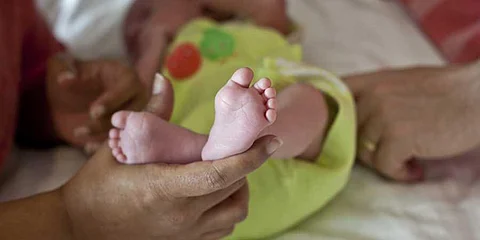

NEW DELHI: Even as the Centre has expressed its intent of adopting measures to control population growth, the total fertility rate in a large part of the country has shown a considerable fall over the last four years, the phase 1 of the National Family Health Survey (NFHS)-5 shows.
For 22 states and UTs for which data has been released on Saturday, the TFR or children born per woman now stands at 1.76 while it was 2 during the NFHS-4, carried out in 2015-16. The TFR in India was 2.2 in the last survey - just a notch above the replacement level of 2.1.
Surprisingly though, Kerala, known for the best human development indices in the country, is the only state where the TFR has increased. During NFHS-4 the TFR in the southern state stood at 1.6 but has now risen to 1.8 and is the same in both rural and urban areas.
There are two states - Telangana (1.8) and Tripura (1.7) - where the TFR has remained the same while there has been remarkable drop in the crucial indicator for most states including Bihar, the state with the highest TFR.
The state now has a TFR of 3, as compared to the last survey when it stood at 3.4. Also, Kerala and Goa are among 8 states where the sex ratio at birth has worsened. While releasing the report, Union Health Minister Harsh Vardhan pointed out that the present NFHS is being conducted in 6.1 lakh sample households, involving household level interviews to collect information on, health and family planning related indicators.
The results from Assam, Bihar, Manipur, Meghalaya, Sikkim, Tripura, Andhra Pradesh, Andaman and Nicobar Islands, Gujarat, Himachal Pradesh, Jammu & Kashmir, Ladakh, Karnataka, Goa, Maharashtra, Telangana, West Bengal, Mizoram, Kerala, Lakshadweep, Dadra Nagar Haveli and Daman & Diu have been made public as Phase 1.
Phase 2 of the survey covering the remaining 14 states and UTs however had their fieldwork suspended due to COVID-19, but have been resumed from November and is expected to be completed by May.
"Substantial improvement in maternal and child health indicators over NFHS-4 was recorded in the present survey," said the minister adding that contraceptive use has increased and unmet need has been reduced in most Phase I states.
The survey also found considerable improvement in vaccination coverage among children age 12-23 months across all states and UTs covered. The survey also found that for the first time women with bank accounts have been recorded separately.